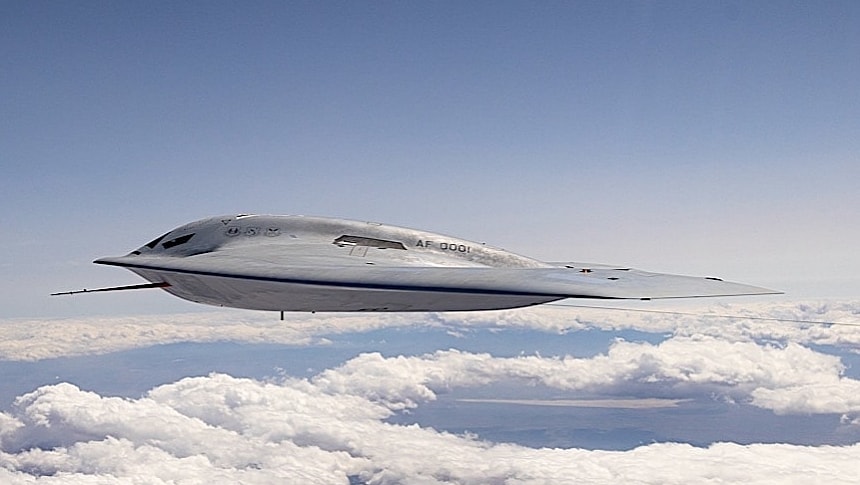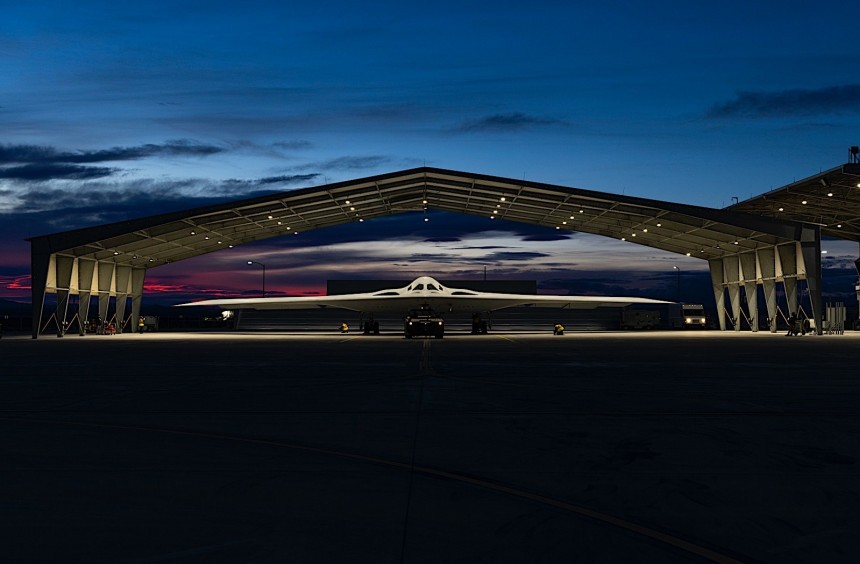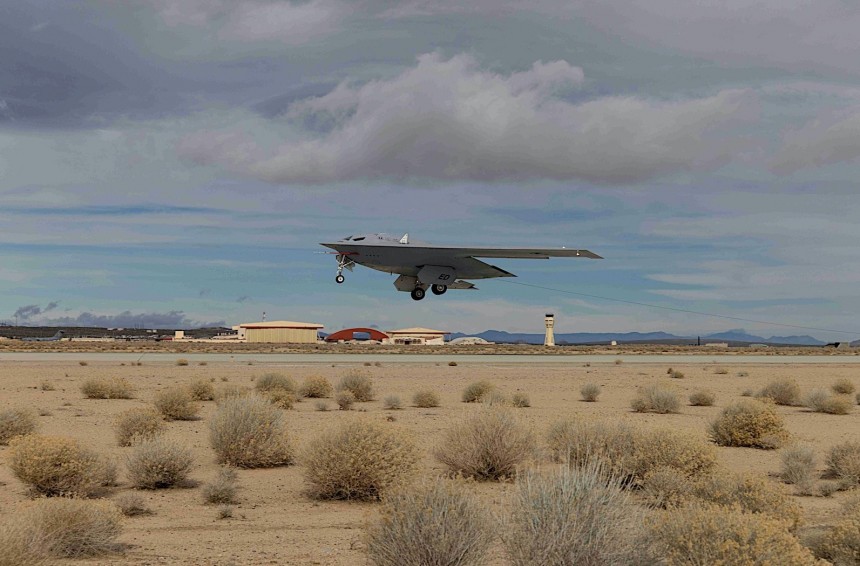The history of aviation is filled with wacky aircraft designs taking to the sky. Some of them, few but still there, were so different from what we're used to (and highly secret) that they had people believe Earth is being visited by aliens. And, if we didn't know any better, seeing the B-21 Raider taking to the sky would have had us believe pretty much the same thing.
The Raider is the talk of the moment in the world of military aviation. First shown (that's a bit of an overstatement, as the project is so secret we barely got to see it) at the end of 2022, the plane is America's first new nuclear bomber in almost three decades.
You probably already know how the country's nuclear bomber fleet looks like at the moment. We've got three such specialized aircraft flying in the hands of the U.S. Air Force (USAF), namely the veteran B-52 Stratofortress (in service since 1955), the B-1B Lancer (which took to the sky for the first time in 1986), and the junior B-2 Spirit, which has been flying since 1997.
The brand-new Raider is here to replace the more younger nuclear bombers currently in service, namely the Lancer and the Spirit. For some reason, the American military decided to keep the Stratofortress flying for a few decades more, which will effectively turn it into the world's first plane of this kind to still be flying a century after it was introduced.
The B-21 began performing test flights last year at the facility in California operated by its maker, Northrop Grumman, but since that time we haven't heard much about how the project is going. That changed this week, when the USAF decided to gives us a glimpse of the aircraft in flight, looking all alien and mean.
The images you see in the attached gallery have been snapped at the Edwards Air Force Base in the same Golden State, where the project "continues to make progress toward becoming the backbone of the U.S. Air Force bomber fleet."
Most of the plane's specs are kept secret, for obvious reasons, but the Air Force describes the thing as a "highly survivable, penetrating strike stealth bomber." It will be powered by an undisclosed number of engines (probably two of them, most likely from the Pratt & Whitney F135 family) that should help it travel long distances.
One of the Raiders main attributes is that, unlike the bombers it is meant to replace, it is of the open systems architecture variety. That should help USAF's people adapt and integrate new technologies into it as they emerge, prolonging its operational life. It is also highly digitalized.
As per officials involved with the program, the Raider is on track to be completed and delivered as scheduled, even if for the civilian world it's unclear when that will be - the military says something about mid-2020s operational readiness.
That may seem quite soon, given how we're already there, but not an unrealistic goal. That's because Northrop Grumman uses a new approach when it comes to new aircraft design, building the first prototypes on the same manufacturing line, with the same manning, tools, and procedures it will use for the production planes. This should allow the lines to start rolling as soon as testing of the plane is complete.
The USAF is one of the largest air forces in the world, fielding some 5,200 aircraft of all types, shapes, and sizes. The majority of them is made up of fighter jets (over 2,000), with bombers being the fewest, just 116 units, as per the numbers provided by Statista. By bombers I mean, naturally, planes designed to carry out only such missions, as there are a number of fighter jets that can become bombers as well when the need arises.
The arrival of the Raider will tip the scales a bit, as even if it will replace some of the existing bombers, no less than 100 of these new aircraft will be made.
The fleet will be spread out across the nation, with the first airmen to get to fly the plane being the ones headquartered at the Ellsworth Air Force Base in South Dakota. This will not be solely the first operating base for the plane, but also the place where pilots will be trained to fly the Raider.
Once enough pilots get the hang of it, the Air Force will field the bomber at two more air bases, Whiteman in Missouri and Dyess in Texas.
We'll keep an eye out for more bits of info on the plane its maker calls the "world's first sixth-generation aircraft to reach the skies," but given the secrecy and importance of this project we're not really hopeful we'll get to know anything new about the capabilities that matter (speed, range, altitude, payload) anytime soon.
You probably already know how the country's nuclear bomber fleet looks like at the moment. We've got three such specialized aircraft flying in the hands of the U.S. Air Force (USAF), namely the veteran B-52 Stratofortress (in service since 1955), the B-1B Lancer (which took to the sky for the first time in 1986), and the junior B-2 Spirit, which has been flying since 1997.
The brand-new Raider is here to replace the more younger nuclear bombers currently in service, namely the Lancer and the Spirit. For some reason, the American military decided to keep the Stratofortress flying for a few decades more, which will effectively turn it into the world's first plane of this kind to still be flying a century after it was introduced.
The B-21 began performing test flights last year at the facility in California operated by its maker, Northrop Grumman, but since that time we haven't heard much about how the project is going. That changed this week, when the USAF decided to gives us a glimpse of the aircraft in flight, looking all alien and mean.
Most of the plane's specs are kept secret, for obvious reasons, but the Air Force describes the thing as a "highly survivable, penetrating strike stealth bomber." It will be powered by an undisclosed number of engines (probably two of them, most likely from the Pratt & Whitney F135 family) that should help it travel long distances.
One of the Raiders main attributes is that, unlike the bombers it is meant to replace, it is of the open systems architecture variety. That should help USAF's people adapt and integrate new technologies into it as they emerge, prolonging its operational life. It is also highly digitalized.
As per officials involved with the program, the Raider is on track to be completed and delivered as scheduled, even if for the civilian world it's unclear when that will be - the military says something about mid-2020s operational readiness.
That may seem quite soon, given how we're already there, but not an unrealistic goal. That's because Northrop Grumman uses a new approach when it comes to new aircraft design, building the first prototypes on the same manufacturing line, with the same manning, tools, and procedures it will use for the production planes. This should allow the lines to start rolling as soon as testing of the plane is complete.
The arrival of the Raider will tip the scales a bit, as even if it will replace some of the existing bombers, no less than 100 of these new aircraft will be made.
The fleet will be spread out across the nation, with the first airmen to get to fly the plane being the ones headquartered at the Ellsworth Air Force Base in South Dakota. This will not be solely the first operating base for the plane, but also the place where pilots will be trained to fly the Raider.
Once enough pilots get the hang of it, the Air Force will field the bomber at two more air bases, Whiteman in Missouri and Dyess in Texas.
We'll keep an eye out for more bits of info on the plane its maker calls the "world's first sixth-generation aircraft to reach the skies," but given the secrecy and importance of this project we're not really hopeful we'll get to know anything new about the capabilities that matter (speed, range, altitude, payload) anytime soon.


















